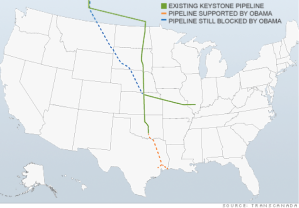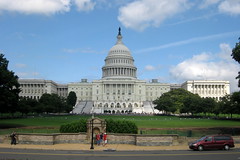A debate that many once thought was done and settled has reared its head again recently, the Keystone XL oil pipeline. Like many issues in America, it has become a partisan rallying point, with Democrats (for the most part) and Republicans setting up camp on different sides of the issue. Many, no doubt, recall the continuous news coverage over this very divisive issue during the previous two years, and they also may recall that news coverage then suddenly stopped.
The issue was brought back into the spotlight earlier this week by (R) Gov. Dave of Nebraska when he endorsed a revised pipeline going through his state.[1] Before we go any further let us refresh our memory on the basic facts about the pipeline:
“The full proposed pipeline, which would cross the U.S. border in Montana, is designed to bring between 500,000 to 700,000 barrels a day from the Canadian oil sands region to refineries on the Gulf Coast. It would shortcut to an existing pipe that goes through much of Canada before cutting into the United States in North Dakota on the way to Cushing.” [2]
The important thing to take away from this is that already there is a pipeline in place. The proposed additions would shorten the distance that the oil needs to travel, while allowing it to be shipped to Gulf refineries, instead of those in the Midwest that currently are used. Another major point to understand before we truly dive into this debate is that part of this proposal already is being put into effect. The part of the pipeline that would take the oil from Cushing, Oklahoma to oil refineries in Texas is going forward. Since this portion of the pipeline does not cross an international border, it does not require federal approval. Furthermore, the Obama administration was never in opposition to this segment of the pipeline, which is expected to be fully operational sometime later this year.[3] Now for many who read this blog, it is obvious on the environmental side why one would be in opposition to this pipeline. Unfortunately, many people find environmental and economic concerns to be mostly incompatible. Consequently, I cannot stress the importance of showing why this pipeline does not only make sense from an environmental perspective, but also from a long-term economic one.
The debate over the Keystone pipeline, like many things, has been caught up in the current contentious disputes raging in America. As such, for many, the debate over the pipeline boiled down to one word– jobs. TransCanada, the company behind the pipeline, estimates that if the entirety of the proposed pipeline were to begin construction, then it would, “would create 20,000 “direct” jobs. That includes 13,000 construction jobs and 7,000 jobs producing commodities, such as pump houses and the pipe itself. [They] also project nearly 120,000 ‘indirect’ jobs — think restaurant workers and hotel employees to support the construction”.[4] Since the Cushing-to-Texas part of the pipeline already is moving forward, we should note that TransCanada states that this segment, in particular, would create 4,000 jobs.2
However, we must take these numbers with a grain of salt as they come from a company that desperately wants the full project to gain approval. When we put these numbers under the microscope, it becomes obvious that they do not add up:
“But TransCanada numbers count each job on a yearly basis. If the pipeline employs 10,000 people working for two years, that’s 20,000 jobs by the company’s count. The estimates also include jobs in Canada, where about a third of the $7 billion pipeline would be constructed. The U.S. State Department, which must green light the project, forecasts just 5,000 direct U.S. jobs over a two-year construction period. Even according to TransCanada, the amount of permanent jobs created would be only in the hundreds.”4
We see now that they are not necessarily lying, but presenting the truth in a misguiding way, to put it lightly. That being said, these are the numbers we should be analyzing if we are to bring jobs into this debate. While jobs are undoubtedly appreciated, we cannot keep jumping from temporary fix to temporary fix. In this country, we do have an employment problem interwoven within our greater economic issues. However, these greater economic problems did not arise from a temporary scenario. Our country and our world have been resting on a structurally flawed economy that needs dramatic restructuring in order to be stable and more beneficial to all. When we pour energy and resources into these temporary beneficial programs, we blind ourselves from the true debate generally and specifically from the trued argument regarding employment. No doubt there will be temporary gains in employment, but we must begin to think in the long-term, and in regards to this perspective, “one study from Cornell University said the pipeline could actually lead to a decline in jobs in the long run. One reasons given for this phenomenon is that the pipeline would lead to higher fuel prices in the Midwest, the study said, and that would slow consumer spending and cost jobs”.4 This brings us to the other argument advocating the construction of the pipeline, gas prices. Why would we turn away this new supply of oil when gas prices are so stubbornly high? The answer is that the argument that this oil will decrease gas prices is a logical fallacy.
The cost of gasoline in this country has risen steadily over the past decade, followed closely by the calls for less oil imports and more domestic oil production. This is a natural conclusion since the price of gas determines the price of so many other products in this country, while dependence on the price restricts or opens up our travels. In my previous posts, I have discussed the increase of domestic oil production; however, simply concluding that increasing the amount of oil brought into the country would automatically lead to lower gas prices is an all-out rejection of the facts. If this pipeline was about getting more oil into this country for cheaper domestic gasoline prices, then the Cushing-Texas part of the pipeline would be unnecessary. Regardless of whether or not the controversial section of the line is finished, connecting to the Gulf refineries would enable up to 700,000 barrels/day of Canadian oil to now have access to global markets. Of those 700,000 barrels/day, Valero has signed a contract for 100,000 barrels a day until 2030. Valero is operating with the full intent of converting these barrels into diesel to export. [5] Furthermore, the lack of a connection to Gulf refineries has led to a glut of gasoline in the Midwest, reducing competition and depressing prices. Cheaper gas prices directly benefit consumer spending and have a beneficial effect all the way down the supply chain. 2
For the President to approve the construction of this pipeline, it must be proven that doing so is in the best national interest. Let us then check the facts and see this truly is the case. When we really focus on the job numbers, we find that despite grand claims by TransCanada, the stark reality is different. While there would certainly would be job creation, the majority of these positions would be temporary. The actual tally of long term jobs created numbers only in the hundreds. In all likelihood, there is a chance that in the long run it could decrease in employment due to higher gas prices throughout the Midwest. When we take these two outcomes into account, it becomes clear that the benefit to the economy and the long term energy independency of this country has been highly overstated. Furthermore, we have not even taken into account the environmental effects of tar-sand oil. On average, emissions from tar sands are 23% higher than oil from more conventional fossil fuel sources.[6] These already higher than average emissions are compounded by the extraction of the oil, which amplifies the environmental effect. Through the process of extracting the tar-sand oil, acres upon acres of carbon absorbing peat lands would be destroyed. Recently, Scientists from the University of Alberta found that, “10 operational oil sands mining projects would destroy enough peat lands to release 11.4 million to 47.3 million metric tons of stored carbon into the atmosphere. That release is the equivalent of seven years’ worth of emissions from the oil sands mining region”. [7] The damage continues even beyond this initial carbon release. What were once carbon absorbing peat lands will be replaced by dry forests which will take in significantly less carbon.
When we consider all the factors, combined with and all the facts concerning the Keystone XL pipeline, it is easy to see that it is not in the public interest. Not only the controversial international section, but the Cushing-Texas portion as well. We have a company, TransCanada, which has skewed the facts and has allowed falsehoods (i.e. the jobs and cheap gas argument) to be publicly displayed as truths. It is true, as many of the columnists of my sources have noted, that stopping this pipeline is not a silver bullet for global warming. However, the point also is continuously made that if we cannot stand up to projects such as these, then what hope do we have? To end global warming and to possess more economic security, we must begin cutting our dependency on fossil fuels altogether, both imported and domestically produced. If we do not pick a point to begin pushing back, then we never will do so. If we allow one project such as this to go forward, while recognizing the overall dangers, how can we stop others? The pushback has to begin somewhere and what better way than against a pipeline dedicated to one of the most polluting fossil fuels in the world? Let’s work hard to push this project back now so that we may live green, be green.
By Sean P. Maguire
[1] http://abcnews.go.com/Politics/OTUS/keystone-pipeline-decision-tests-president-obama-jobs-climate/story?id=18292687
[2] http://money.cnn.com/2012/03/22/news/economy/keystone-pipeline/index.htm
[3] http://money.cnn.com/2012/02/27/news/companies/keystone_pipeline/index.htm?iid=EL
[4] http://money.cnn.com/2011/12/13/news/economy/keystone_pipeline_jobs/index.htm?iid=EL
[5] http://dirtyoilsands.org/files/OCIKeystoneXLExport-Fin.pdf
[6] http://www.europeanvoice.com/article/2011/february/tar-sands-creates-more-pollution-than-other-fossil-fuels-/70152.aspx
[7] http://www.scientificamerican.com/article.cfm?id=oil-sands-co2-emissions-higher-than-thought








